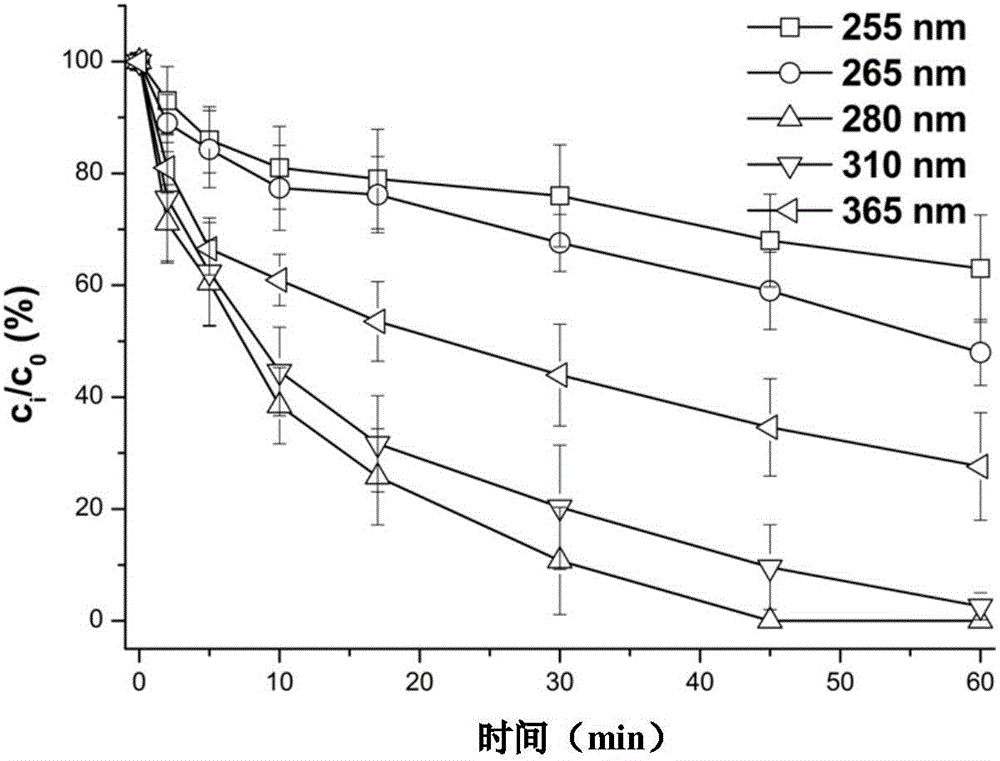Method for targeted degradation of quinolone antibiotics in water and multiband ultraviolet (UV) radiation device used for method
An irradiation device and quinolone technology, applied in chemical instruments and methods, water pollutants, water/sewage treatment, etc., can solve the problems of no involvement, few toxic by-products, etc., achieve good effect, low product toxicity, and accelerate mineralization The effect of degradation properties
- Summary
- Abstract
- Description
- Claims
- Application Information
AI Technical Summary
Problems solved by technology
Method used
Image
Examples
Embodiment 1
[0036] Embodiment 1: Design and manufacture of multi-band ultraviolet irradiation device
[0037] 1. Materials
[0038] Multi-band UV irradiation light source 1: UV-LEDs capable of emitting 255nm, 265nm, 280nm, 310nm and 365nm, and the irradiation power of a single module is 5-15mW.
[0039] Heat dissipation device 2: Contains heat dissipation fan and copper sheet. According to the size of the light source, select the appropriate size of heat dissipation fan and copper sheet for assembly.
[0040] Stirring device 4: a horizontal rotary oscillator is used.
[0041] Reaction Vessel 5: A custom-made fixed-volume circular glass vessel.
[0042] Module frame 3: PLA engineering plastics and ABS engineering plastics are used.
[0043] Power supply 6: Select an appropriate AC-DC conversion power supply according to the rated power and rated current of the light source.
[0044] 2. Method
[0045] Design of the device: AutoCAD is used to design the shell and support of the UV irra...
Embodiment 2
[0048] Example 2: Screening for the dominant wavelength of degradation of ciprofloxacin
[0049] 1. Materials
[0050] Multi-band ultraviolet irradiation device: the multi-band ultraviolet irradiation device manufactured in Example 1 is adopted, and the emission wavelength of the device includes five bands of 255nm, 265nm, 280nm, 310nm and 365nm.
[0051] Agents and solutions: ultrapure water (resistivity 18.2MΩ, dissolved organic carbon DOC2 HPO 4 12H 2 O 0~200mg / L, KH 2 PO 4 0~100mg / L).
[0052] 2. Method
[0053] Weigh 1.0mg of ciprofloxacin solid and add it into 1L phosphate buffer solution (pH=7.0) to prepare a 1.0mg / L ciprofloxacin aqueous solution system. Take 20mL ciprofloxacin aqueous solution and place it under UV radiation. In the reaction vessel 5 of the illumination device. Turn on the power supply 3, and adjust the irradiation intensity of the multi-band UV irradiation light source 1 to 0.025mW / cm before the reaction 2 (the surface of the reaction liquid...
Embodiment 3
[0060] Example 3: UV / H 2 o 2 System degradation of ciprofloxacin in water
[0061] 1. Materials
[0062] Multi-band ultraviolet irradiation device: the multi-band ultraviolet irradiation device manufactured in Example 1 is adopted, and the emission wavelength of the device includes five bands of 255nm, 265nm, 280nm, 310nm and 365nm.
[0063] Agents and solutions: ultrapure water (resistivity 18.2MΩ, DOC2 o 2 , volume concentration 30%), acetonitrile (HPLC grade), formic acid (HPLC grade), phosphate buffer solution (pH=6.85, Na 2 HPO 4 12H 2 O 0~200mg / L, KH 2 PO 4 0~100mg / L).
[0064] 2. Method
[0065] Take 1.0mg of ciprofloxacin solid and add it to 1L phosphate buffer solution to prepare a 1.0mg / L ciprofloxacin aqueous solution system. Before the reaction, adjust the irradiation intensity of UV-LED to 0.025mW / cm 2 (the surface of the reaction liquid surface). Take 20mL of ciprofloxacin aqueous solution and place it in the reaction vessel of the UV irradiation devi...
PUM
 Login to View More
Login to View More Abstract
Description
Claims
Application Information
 Login to View More
Login to View More - R&D
- Intellectual Property
- Life Sciences
- Materials
- Tech Scout
- Unparalleled Data Quality
- Higher Quality Content
- 60% Fewer Hallucinations
Browse by: Latest US Patents, China's latest patents, Technical Efficacy Thesaurus, Application Domain, Technology Topic, Popular Technical Reports.
© 2025 PatSnap. All rights reserved.Legal|Privacy policy|Modern Slavery Act Transparency Statement|Sitemap|About US| Contact US: help@patsnap.com



